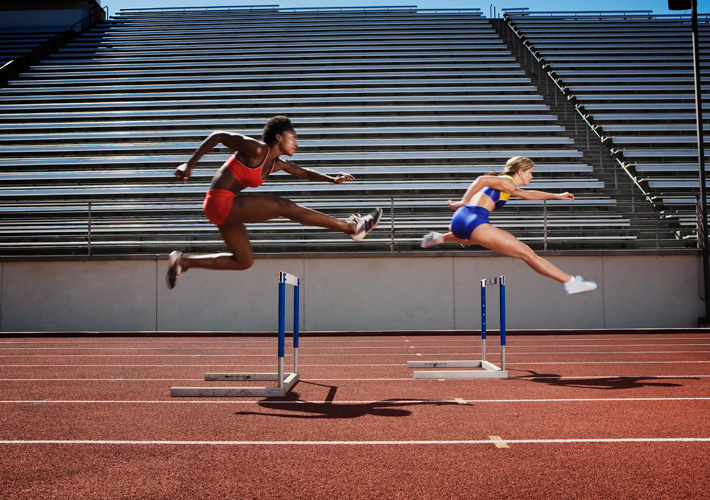
How Olympic Sports are Made Safer by ‘Hidden’ Standards – Podcast
As the world heats up for the 2024 Paris Olympics, fans will be closely scrutinizing fouls, outs, and scores. But a second set of regulations hovers behind the action: safety standards.
From the surfaces athletes play on to the headgear that reduces risk of injuries, standards are a major component of global sports. And as is often the case, standards are hidden in plain sight, operating in the background thanks to the consumers and experts who work with organizations like ASTM International to make the world safer.
NEVER MISS AN EPISODE: Follow Standards Impact on Spotify
Ahead of the Olympics, Standards Impact hosted discussions with two athletics experts, athletic surfaces consultant John Amato, and Ann Kitt Carpenetti, founding partner of Intent Operations and an advocate for the rapidly growing sport of lacrosse.
During the conversation, Amato spoke about how standards operate to reduce risk in sports and how his background in engineering changed the way he looks at sports.
Read an excerpt of the discussion or listen to the full episode below.
JP Ervin: In the standards world, we know that sometimes what we do is hidden behind the scenes. People don't always notice what goes into making the world safer. People don't know all the time where roads and things like that come from and how they function. Sports strikes me as an interesting case because people do see some of the rules. There are safety rules built into the games, they see helmets or other safety equipment sometimes. But a lot of people don't look deeper than that and assume it's chance or what players do on the field that makes everyone safe. What role do you see standards playing in athletics and the broader sports world?
John Amato: To cover first your statement, which I think is spot on, most people are really not aware of what's behind the scenes when it comes to testing and ASTM, how we interface with organizations and regulatory bodies and users and constructors who build facilities that our standards might be used as a basis for. When I talk about the subject, I like to mention that the word safety's a tough word. The word safety is a tough word because everybody looks at it differently. A soccer mom or a soccer dad might look at safety different than a wrestler's parents. When they watch the soccer match and one of the players slammed a person into the mat, the parents would be pretty upset with that.
I like to look at this as reducing the likelihood of risk and reducing the likelihood of risk is we create situations, we create test methods, we pursue criteria, we try and accomplish that goal, reduce the likelihood of risk. We can't make it all go away. We can't make things safe. Most of safety in sports is actually how you play and how athletes interfaced against each other – and it is against each other when you're playing sports.
[….]
Ervin: I've talked to some engineers, and working in that world changes how you see things. I actually have a background in music. It’s sometimes compared. You know what's going on behind the scenes and it changes how you listen to music, or in the case of engineers, it changes how they look at the world around them. Has working in this world changed how you watch sports? Are you sweating the whole time you watch a basketball game, looking at drops of sweat on the court, or watching tennis analyzing the spin?
READ MORE: The Standards Behind the 2024 Paris Olympics
Amato: Yes, of course. If you're interested in something, you'll see it. A perfect example is when watching a football game, when a defensive back takes out the legs of a wide receiver who's up in the air, and he comes down. Same thing in basketball. You watch people playing on a wooden floor. People in basketball, they're in the air pretty high, and a lot of times they land on their backs, their butts, their shoulder. What's the impact of that load when they hit the floor? What force reduction is developed? How much does the floor deflect? All those things.
Every time I watch a game, if there's something I'm doing, I see it. You've watched football and you've seen in soccer. You're on synthetic turf and you've seen the fly of the in-fill, and you go, wow. Baseball's a great sport to think about those kinds of things in forces. A softball's the same thing, but a softball is big. It doesn't have the same behavior. A baseball, you can make that move. You can make that fly and spin off a bat, and it changes the direction. Just imagine that. And these guys, the level they perform at the pro level of the major leagues, that's just incredible stuff. And the guy catching a ball, think about that. It's moving 110 miles an hour and you're running, you're trying to catch a ball that moving that fast, and you've got to have that hand-eye coordination and the speed to be able to catch it, change hands, and throw it. All that stuff is just amazing. Sports is a great study.
Learn more about Standards Impact on our Buzzsprout page or wherever you get your podcasts.
 SN Home
SN Home Archive
Archive Advertisers
Advertisers Masthead
Masthead RateCard
RateCard Subscribe
Subscribe Email Editor
Email Editor